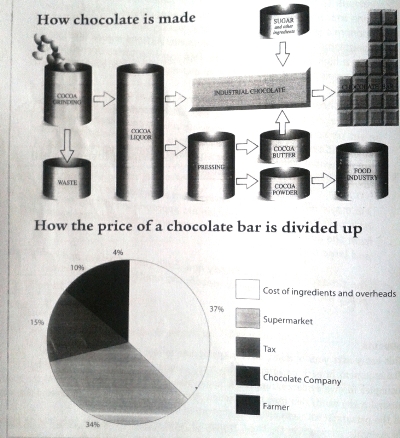Question:
The diagrams below show how chocolate is made and how the price of a chocolate bar is divided up among those involved in the process.
Summarise the information by choosing and reporting the key features, and make any relevant comparisons.
Contents:
The two diagrams compare the process of chocolate manufacturing and proportion of a chocolate bar's cost. The value of a chocolate bar is measured by percent. Overall, it can be clearly seen that sale of a chocolate bar gives influence to divide up from producer to supermarket, and the retail price of a chocolate bar is matched with chocolate-making processes.
To begin, chocolate beans are grinded until smooth. In filtering process, It outcomes dregs and liquor of cocoa. In the cocoa liquor step, there are two ways to continue process of chocolate production.Fisrtly, Industial chocolate can be the fastest production to make a chocolate bar, on the other hand, sugar and other ingredients can be needed to produce it. Secondly, Cocoa liquor is pressed to become butter and powder. Afterwards, food industrial processes cocoa powder to manufacture it become others while butter is distributed to industrial chocolate to make a chocolate bar.
A closer look at the figure reveals that the percentage of cost of ingredients and overheads is the highest about 37% in the a retail price of a chocolate bar. It is followed by supermarket which gets 34% in the money of chocolate product. Having said that, a rather minimum 15% is taken by Government for tax while chocolate factory receives 10% in the sale of product. In contrast, the lowest retail price around 4% is allocated to farmer as produser of cocoa beans.
The diagrams below show how chocolate is made and how the price of a chocolate bar is divided up among those involved in the process.
Summarise the information by choosing and reporting the key features, and make any relevant comparisons.
Contents:
The two diagrams compare the process of chocolate manufacturing and proportion of a chocolate bar's cost. The value of a chocolate bar is measured by percent. Overall, it can be clearly seen that sale of a chocolate bar gives influence to divide up from producer to supermarket, and the retail price of a chocolate bar is matched with chocolate-making processes.
To begin, chocolate beans are grinded until smooth. In filtering process, It outcomes dregs and liquor of cocoa. In the cocoa liquor step, there are two ways to continue process of chocolate production.Fisrtly, Industial chocolate can be the fastest production to make a chocolate bar, on the other hand, sugar and other ingredients can be needed to produce it. Secondly, Cocoa liquor is pressed to become butter and powder. Afterwards, food industrial processes cocoa powder to manufacture it become others while butter is distributed to industrial chocolate to make a chocolate bar.
A closer look at the figure reveals that the percentage of cost of ingredients and overheads is the highest about 37% in the a retail price of a chocolate bar. It is followed by supermarket which gets 34% in the money of chocolate product. Having said that, a rather minimum 15% is taken by Government for tax while chocolate factory receives 10% in the sale of product. In contrast, the lowest retail price around 4% is allocated to farmer as produser of cocoa beans.

IELTS_Puji.jpg
